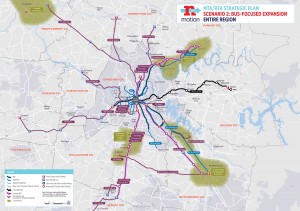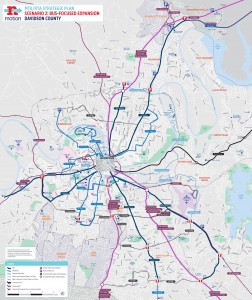Bus-Focused Expansion would provide many of the same improvements as the Comprehensive Regional Transit System, but would focus on bus service improvements to reduce costs, and expand and improve service to a lesser extent. Transit ridership would increase, but not as significantly as with Scenario 1.
- Commuter Rail: Additional service on Music City Star, including an extension to Lebanon’s Expo Center
- Full Bus Rapid Transit (BRT): Dickerson, Gallatin, Murfreesboro, Nolensville, West End, and Charlotte
- Rapid Bus (“BRT–Light”): Shelby, Hillsboro, Metro Center, 12th Ave. South, Bordeaux, Edgehill, Jefferson
- Regional Rapid Bus Routes: Gallatin, Nolensville, and Murfreesboro
- Freeway Bus Rapid Transit: Franklin, Murfreesboro, Clarksville, and Gallatin Corridors
- Bus-on-Shoulder: Along freeways without Freeway BRT facilities where feasible
- Express Bus: New service to Airport, Murfreesboro-Cool Springs, White House/Portland, Columbia, and Ashland City; Additional trips on all routes
- New Local Service: Brentwood, Cool Springs, Hendersonville, and Gallatin
- Longer Service Spans and Better Frequency: 5 a.m to midnight with 10-15 minute frequencies on key routes.
- New Crosstown Routes: Nine



Lebanon needs a bus line – and with the Mt. Juliet bus line no longer in service – these two populated areas are being left out of the options beyond the train service – for people who have different schedules – need a few more options.
Two out of 3 of these plans from a BRT with dedicated lanes along West End Avenue. I realize these are preliminary and conceptual, but we had a HUGE battle over the Amp a few years ago in part because the city government, chamber of commerce and “committee of insiders” recruited to sell this plan to Nashvillians accentuated the positives and ignored the negatives, which were significant:
– 3 interstate overpasses that can only be widened for BRT at significant cost (so the end result is that cars loss a lane at already congested intersections to accommodate buses);
– Need to expand width of roads west of 440 to accommodate would require eminent domain in an expensive residential area (the choice is either expand the roadway to provide dedicated lanes to buses or provide car traffic with only 1 lane in either direction);
– The traffic delays due to lengthy construction of dedicated BRT lanes would take 30 years of BRT service to break even.
Another issue is that BRT promoters claim that BRT is “more comfortable” and desirable without pointing out that at least half of the capacity of BRT buses is for standing passengers. One major advantage of riding a bus is that you can read–not possible if you’re standing. If you are asking people to make a major financial commitment to various modes of public transit, you need to be totally honest about the advantages and drawbacks, and most people are going to consider buses that offer standing room only to more than half of their passengers a negative.
This option makes the most sense to me for right now, both financially and for quick implementation of needed improvements. It must be well publicized, well run, and meet the needs of potential riders to get more people “on board” and willing to leave their cars at home. Above all it must be a desirable option. Work with specific large employers, and clusters of smaller ones, to get buy in from their employees to try the improved services. More crosstown routes that connect with major roadways into and out of downtown are crucial.
Once this in place and running, planners should aggressively pursue the planning of light rail as the next phase, and begin steps to put that option in place as needed. I think it is wise to start with something we already have in place and enhance it, then grow into light rail gradually. This option will give the city time to do that while meeting immediate transportation needs of our citizens.
Cats and dogs can smell odors even when we canbnot and return to the area where urine was prevfiously deposited.
Need to add Goodlettsville to local service
The Bus Rapid Transit option is the smart choice for Nashville’s long-term growth. It will provide a similar return-on-investment compared with the light-rail option but at a significant cost savings to all of us. Also, it will be much easier to build and much simpler to maintain over time. Additionally, due to the lower cost, it will allow for more transportation lines which will enable more end-to-end routes, thus providing better service and useabilty. Cleveland has a shining example of BRT called the the Healthline, it’s been a huge success that we can learn from. Other countries such as China, Brazil, and Colombia have successfully built extensive BRT systems over the past 20 years that transport tens of thousands of people each day, again we can learn from their best practices. The detractors say that BRT won’t encourage enough riders because ‘people just won’t ride in buses in the U.S.’ and ‘buses are slow’. That’s simply not true. Americans are open to use a system that is affordable and gets them to their destination. It’s important to properly market and educate about the quality and performance of BRT, it’s dedicated lanes and advanced stoplight contols that allow quick end-to-end rides. Nashville has the opportunity now to embrace BRT and become a world-class, transportation leader for other cities to follow.
See the following links for more BRT information: https://en.wikipedia.org/wiki/HealthLine
https://en.wikipedia.org/wiki/TransMilenio
https://en.wikipedia.org/wiki/Bus_rapid_transit_in_Brazil